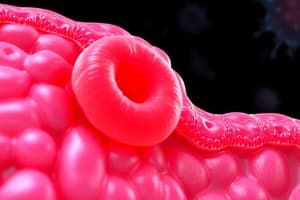Podcast
Questions and Answers
What is the first stage that occurs at the fracture site during the healing process?
What is the first stage that occurs at the fracture site during the healing process?
- Formation of the osteoid callus
- Creation of the hard bony callus
- Removal of unneeded callus by osteoclasts
- Development of haematoma (correct)
What type of callus is formed after the soft callus during bone healing?
What type of callus is formed after the soft callus during bone healing?
- Fibro-cartilagenous callus (correct)
- Osseous callus
- Granulation tissue
- Scar tissue
Which healing process is characterized by minimal tissue destruction and results in thin scar formation?
Which healing process is characterized by minimal tissue destruction and results in thin scar formation?
- Granulation tissue formation
- Complications of wound healing
- Primary union of wounds (correct)
- Secondary union of wounds
Which of the following factors does NOT contribute to the failure of bony union?
Which of the following factors does NOT contribute to the failure of bony union?
Which condition refers to a double-ended tract usually occurring in hollow organs?
Which condition refers to a double-ended tract usually occurring in hollow organs?
What is NOT considered a complication of wound healing?
What is NOT considered a complication of wound healing?
What is the primary distinction between repair by regeneration and repair by granulation tissue?
What is the primary distinction between repair by regeneration and repair by granulation tissue?
What is the main cellular component responsible for the formation of granulation tissue?
What is the main cellular component responsible for the formation of granulation tissue?
What process involves the removal of unneeded callus during bone healing?
What process involves the removal of unneeded callus during bone healing?
Which type of cells can proliferate continuously throughout life?
Which type of cells can proliferate continuously throughout life?
What determines the type of repair that occurs following tissue damage?
What determines the type of repair that occurs following tissue damage?
What is a possible outcome of severe liver cell injury when the fibrous framework is destroyed?
What is a possible outcome of severe liver cell injury when the fibrous framework is destroyed?
Which of the following best describes stable cells?
Which of the following best describes stable cells?
In the central nervous system, what happens to permanent cells after injury?
In the central nervous system, what happens to permanent cells after injury?
What complication can occur if the ends of a cut nerve are not aligned after injury?
What complication can occur if the ends of a cut nerve are not aligned after injury?
Which type of cells are categorized as permanent cells?
Which type of cells are categorized as permanent cells?
Flashcards are hidden until you start studying
Study Notes
Repair and Healing
- Repair or healing is the body's natural process of replacing damaged tissue with healthy new tissue.
- There are two main types of repair:
- Regeneration: Damaged tissue is replaced with the same type of cells.
- Granulation or Fibrosis: Damaged tissue is replaced by granulation tissue which eventually matures into fibrous tissue.
Factors Determining Repair Type
- The type of repair depends on the type of cells and their ability to divide and proliferate.
- Three types of cells are distinguished based their ability to divide:
- Labile cells: Constantly proliferate throughout life (e.g., skin, mucous membranes, urinary bladder, GIT, respiratory tract, hematopoietic and lymphoid cells).
- Stable cells: Can proliferate when needed (e.g., liver, pancreas, glands, osteoblasts, chondroblasts, fibroblasts).
- Permanent cells: Cannot proliferate (e.g., cardiac and skeletal muscle, nerve cells).
Examples of Repair by Regeneration
- Skin Regeneration: Epidermis regenerates easily, while dermis heals by granulation tissue formation (fibrosis).
- Liver Regeneration: Regeneration is possible after mild injury with intact fibrous framework. Severe injury with destroyed fibrous framework leads to irregular fibrosis and cirrhosis.
- Nervous System: No regeneration occurs in the central nervous system. Regeneration is possible in peripheral nerves, but only if the two ends of the cut nerve are in direct opposition. If not, a painful mass called a traumatic neuroma forms.
Examples of Repair by Granulation Tissue (Healing by Fibrosis)
-
Healing of Bone Fracture:
- A hematoma (blood clot) forms at the fracture site with the release of growth factors.
- Fibroblasts and new capillaries invade the hematoma, forming a soft callus (procallus).
- The procallus is converted to fibro-cartilagenous callus, then osteoid callus, and finally to hard bony (osseous) callus.
- Excess callus (external and internal) is removed by osteoclasts, and the intermediate callus is remodeled.
- Bone marrow regenerates later.
-
Failure of Bony Union:
- Improper immobilization leading to fibrous union
- Impaired blood supply
- Infection at the fracture site
- Soft tissue interference with bony ends
- Impaired nutrition and old age
- Diabetes mellitus and glucocorticoid therapy
-
Granulation Tissue Formation: Granulation tissue is comprised of proliferating fibroblasts and anastomosing capillaries. It matures into fibrous tissue through Fibrogenesis (collagen production) and Angiogenesis (new blood vessel formation).
Healing of Wounds
- Primary Union (Healing by First Intention): Occurs in clean incised wounds with minimal tissue destruction and approximated edges (e.g., surgical wounds). Results in thin scar formation.
- Secondary Union (Healing by Second Intention): Occurs in gaping wounds, septic wounds, or abscesses where the edges are not approximated. Results in large scar formation.
Complications of Wound Healing
- Chronic Ulcer: Persistent loss of continuity of the covering skin or mucous membrane.
- Chronic Sinus: A blind-ended tract between a deep wound and the skin.
- Chronic Fistula: A double-ended tract, usually in a hollow organ.
- Keloid: A large, projecting scar covered by thin stretched skin.
- Interference with Movement: Scar tissue can restrict movement.
- Implantation of Epidermoid Cyst: Can occur when skin is buried during surgery.
- Malignant Transformation: Can occur in old scars, especially burn scars.
Studying That Suits You
Use AI to generate personalized quizzes and flashcards to suit your learning preferences.




